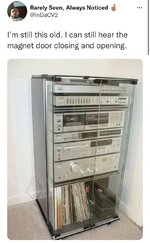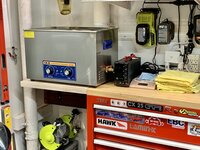Navigation
Install the app
How to install the app on iOS
Follow along with the video below to see how to install our site as a web app on your home screen.
Note: This feature may not be available in some browsers.
More options
Style variation
-
Hi Guest !
Welcome to the 500Eboard forum.
Since its founding in late 2008, 500Eboard has become the leading resource on the Internet for all things related to the Mercedes-Benz 500E and E500. In recent years, we have also expanded to include the 400E and E420 models, which are directly related to the 500E/E500.
We invite you to browse and take advantage of the information and resources here on the site. If you find helpful information, please register for full membership, and you'll find even more resources available. Feel free to ask questions, and make liberal use of the "Search" function to find answers.
We hope you will become an active contributor to the community!
Sincerely,
500Eboard Management
You are using an out of date browser. It may not display this or other websites correctly.
You should upgrade or use an alternative browser.
You should upgrade or use an alternative browser.
OWNER jlaa (500E & w210 E320 & w220 S350)
- Thread starter Jlaa
- Start date
I have dozens of tapes recorded by a friend who shares my musical tastes. He recorded them In the early nineties from expensive state of the art direct drive turntables. Recorders and amps were the kind of stuff you guys pine for. All where recorded on Maxell XL 2s high cr02. These tapes still sound great. Noticeably better than CDs. They sound VERY good in my 1432 with rainbows up front. The exciting thing about your post for me lies in the fact I've never even tried them with the CR feature engaged! Turns out I may be in for an improved experience!
You can't beat JL Hooker and the blues.
drew
You can't beat JL Hooker and the blues.
drew
Last edited:
I will be waiting with baited breath for your impressions!I have dozens of tapes recorded by a friend who shares my musical tastes. He recorded them In the early nineties from expensive state of the art direct drive turntables. Recorders and amps were the kind of stuff you guys pine for. All where recorded on Maxell XL 2s high cr02. These tapes still sound great. Noticeably better than CDs. They sound VERY good in my 1432 with rainbows up front. The exciting thing about your post for me lies in the fact I've never even tried them with the CR feature engaged! Turns out I may be in for an improved experience!
You can't beat JL Hooker and the blues.
drew
Since we on the tape subject, ventured into ebay, just to take a "looksie" around, so tell me, kind sir, are TEAC tapes are made of some "unearthed" materials? In the past life, I've had a few, don't remember them costing this:

or this





TEAC CRC 90 HIGH BIAS BLANK RECORDING CASSETTE TAPE GOLD REELS "Still SEALED" | eBay
, so TEAC CRC Cassette is Suitable for all Types of Music Recording. TEAC CRC 90 Enables you to Enjoy Excellent Sound Performance. The Sensitivity in the High Frequency Range has Been. You willNOT BE DISAPPOINTED in this Tape.
www.ebay.com
or this

* Rare Teac Studio 52G Metal Reel Tape * New Sealed Cassette * 1 Qty | eBay
Rare Teac Studio High Precision Mechanism 52/G Metal Position Metal Tape & Metal Reel * Made In Japan * Gold Color Reels * Cassette Is Brand New * Made 1984 *1 Qty.
www.ebay.com



Those are more for "retro reel style junkies enthusiasts", some still exist out there. I too had few of them back in the 80s. The cassettes with such reels (originally made that way) are very hard to find these days, but some people are still buying them. To use them in our cars is a waste of money; once you insert the cassette in the player, you will not see the reels any more.
Last edited:
Those are more for "retro reel stylejunkiesenthusiasts", some still exist out there. I too had few of them back in the 80s. The cassettes with such reels (originally made that way) are very hard to find these days, but some people are still buying them. To use them in our cars is a waste of money; once you insert the cassette in the player, you will not see the reels any more.
Right! Those “reel to reel” look cassettes are $$$$$$$$$$$$$$$$$. Like nearly 500E Euro headlight $$$$$$$$$$.
If you recall, nearly all advertisements for home cassette decks in the 80s pictured the decks using “reel to reel” look cassettes.
Yes, of course I do.If you recall, nearly all advertisements for home cassette decks in the 80s pictured the decks using “reel to reel” look cassettes.
Those times were different, many memories are coming back. Driving now a Mercedes from that era and listening to that music on cassettes is a one of a kind feeling, hard to get otherwise.
Yes, of course I do.Those cassettes were very hard to come by, especially that at that time I lived in a communist country. Each time I was looking at a flyer with a new deck, I was drooling. In the end I got a Grundig, Akai or Onkyo were out of my reach.
Those times were different, many memories are coming back. Driving now a Mercedes from that era and listening to that music on cassettes is a one of a kind feeling, hard to get otherwise.
I think the 1985 version of @liviu165 is drooling now at what 2021 version of @liviu165 is able to enjoy.
I replaced the auxiliary fan resistor. First off, I reference this treasure / goldmine of v8 w124 wisdom that @Klink posted some years ago, and @gsxr was kind enough to remind me of this morning:
Indeed, my original auxiliary fan resistor was encased in that despised sarcophagus that @Klink heaped hate upon so many years back:


and luckily no such melty black plastic ring was to be found anywhere near the alarm horn, located directly above the sarcophagus:

Sarcophagus lid be gone!!!!!!! Remove yourself from my sight!!!


Crusty old aux fan resistor still residing in the car.
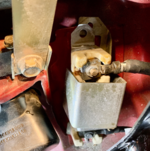
Comparison of old and new resistor below. The old one didn't look too bad. This one has lived an OK life it seems without excessive amounts of torture. Maybe my car was one of the lucky ones with a properly-adjusted Sachs visco fan clutch from the factory, which avoided having the electric fans having to blaze away constantly to make up for a no-good-fan-clutch when the AC refrigerant pressure was over 16bars. Regardless, as my visco fan clutch has been replaced with the ACM unit that engages a tad TOO EARLY (a good thing save for a bit of roar noise) I do not worry about it fan clutch any more.
I should note ---- I SURE AM GLAD THAT I JUNKED THE COOL HARNESS RESISTOR THING some years ago. That stupid thing always kept my electric fans blazing ----- and I am sure that would lead to long term thermal overstress of the aux fan resistor.
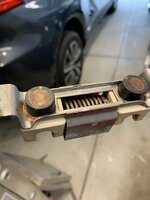

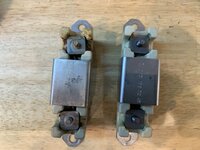





Reassembled the new aux fan resistor with the base-plate / heat shield into the car. In my infinite lack-of-wisdom, I decided NOT to remove the headlight when doing this. The bottom mounting nut is a BEAR to get on this way. Nearly blind access AND you can barely get your fingers on it. Very frustrating. It took me a whole hour to get it reinstalled.


Look carefully above. Do you notice anything wrong? THAT'S RIGHT! I assembled the base-plate / heatshield the WRONG WAY AROUND!!!! ARRRRRRRRRGGGHGHGHGHGHGHGHGHGH.
So I flipped it around. This time, removal / reinstallation took me 20 minutes, even with that blasted impossible nut.

Cleaned up the horn. @Klink was right, these stupid horns get unshiny in short order --- I can see why MB made a stupid melty plastic trim ring for it.



I jumped the two connectors going to the red pressure switch nearby and verified that the low-speed fans operate just fine.
At full tilt low-speed boogie, the heat shield, which is an integral part of the resistor baseplate, gets to about 77F. (Garage temps were in the high 60s). However, JEEEEPERS, I can see that peak readings for the resistive coil / electrical terminal on the resistive coil get as high as 300F. NO WONDER THESE THINGS BAKE!!!! I wonder if anyone has actually re-installed the sarcophagus, or has everyone just left the sarcophagus off? As well, I wonder if anyone else has taken temperature readings?
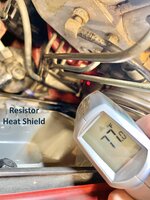


Wow, that's an exquisite looking repair! Nice work. Here's what I wanted to rant on earlier and couldn't. There are some "off label" use prescriptions here in my post, so caution is advised and YMMV:
First here's what actually goes wrong with these resistors: They were mounted in that awkward position that causes all of the heat from that glowing! (yes, look at it in the dark) resistor element to rise upwards over the upper wire termination. This extreme thermal exposure with resultant expansion and contraction causes the threaded attachment to eventually loosen. The loose connection eventually gains resistance to the point that it overheats and burns. This heat also travels along the copper, causing the insulation to burn, which in turn also releases corrosives that infect the termination. The syndrome continues unabated until the connection finally fails and/or the wire breaks.
Two things hasten this process along: The first and most common is that many, if not most of these cars have fan clutches that haven't worked correctly, if at all, since the day the car was built. This caused the auxiliary fans to work almost constantly in a futile effort to cool these lumps off.
Note that if the air conditioning compressor is engaged, the auxiliary fan low speed is usually switched on in a very short time as the refrigerant pressure rises to above 16 bar shortly after start up on a summer day. That is all good. That's why the auxiliary fans are there. They protect and enhance the air conditioner in those conditions where the refrigerant pressure is high, the engine fan is idling (not yet heated up enough to engage), and the vehicle is at low speeds or stationary. In the cars with inadequate fan clutch action, (remember, that's a lot of them), the auxiliary fan low speed was switched on in almost any operating condition whenever the ac compressor was engaged, so that terminal junction got a lot of heat a lot of the time. It didn't stand much chance of survival. Also not surviving this abuse were the low speed auxiliary fan fuses which were either 15 or 16 amp depending on which of the several wiring and relay arrangements that these cars had. Regardless of that and on the subject of fuses, only the Germans would fuse a circuit with a fuse having a capacity only slightly above the current passed through a correctly functioning circuit so that the fuse is frequently overheated and cracks incessantly in hot climates just from the constant thermal cycling. Hello poor ac performance and short lifespan of the high pressure ac componentry including poor Mr. Kompressor. Also, hello such concoctions as the "cool harness" causing the high speed auxiliary fans to work incessantly while duty cycling off the ac compressor to prevent high temperatures, the engine temperature in this case, not yours. The various inoperative fan clutches and low speed auxiliary fans running around out there are why people think these things are just the cat's ass.
WARNING, AUCHTUNG! An "Off label use alert" is in effect for all of the following: You are free to agree or disagree. I've been through these circuits 6 ways from Sunday and have at least 20 years of real world "testing" experience for the advice I offer below. But be warned that it is "approved" by no one, and "tested and verified" by no laboratory or engineer! If you do what I suggest and your car and whatever it is parked in burns to the ground, I KNOW that none of this advice caused it, but still don't tell me about it because I won't care, because as I said, I know this didn't cause it. There, you've been warned.
Now here's what I advise:
For all 107, 123, 126, and 124, If you have a red ceramic 16 amp auxiliary fan fuse in your fuse box [fuse D on the 124], replace it with a blue 25A fuse. It will stop chronically cracking putting thousands of dollars of your refrigeration system at risk. If you develop an actual high current consumption situation, it will burn open as it should and protect the wiring. [Note: This applies to non-V8 models of the 124 chassis. The 400E/500E do not use fuse D as the power feed for the twin auxiliary fans.]
[The pre-facelift, 1992-1993 USA model year 400E/500E have an external 30A strip fuse, typically located behind the brake booster. This 30A strip fuse feeds the single large fan relay K9. See attached image/screenshot with schematic from ETM.]
For facelift (1994-95 USA model year) E420/E500 only: If you have a blue 15 amp blade fuse in the blue low speed auxiliary fan relay (K9/1), replace it with a yellow 20A fuse for the same reason stated just above. [The high speed relay (K10) may have either a 30A or 40A fuse. See attached FSM ETM PDF; note the schematic differs between -->1993 and for 1994-->.]
The other reason that these resistors cook and fail is that MB kind of mistakenly (IMO again) thought this resistor a hazard early in the V8 124's lifespan. The hazard (ok, usually just some smoke) was actually caused by an aesthetic measure: The cramped quarters in the V8124 caused them to locate the alarm horn in plain sight right there between the brake hydraulic unit and the headlamp. Someone at MB obviously thought that this rude and often corroded bright metal clashed with the acres of black plastic surrounding it. They therefor fashioned a black plastic trim ring that fitted around the circumference of this alarm horn there by making it blend in better with the rest of the black plastic. Low and behold, this plastic ring would get all squidgy from the under-hood heat (remember those fan clutches?), and fall off the alarm horn. Then where would they land? Right on that hot auxiliary fan resistor! How you like that, Smokey?
In response to this, did they have us remove the trim ring from the ATA horns? Yes they did. Then they also built in at the factory, or had us retrofit a freaking sarcophagus around that damn resistor! That's why most of these cars have an additional perforated heat shield around these things. It was yet one more thing that tried to kill these overworked resistors and their associated connections. Many of these shields are missing because technicians recognized them for the additional menace as opposed to safeguard that they actually were and they often didn't seem to find their way back onto the vehicles. So here's another off label use. Make sure there's nothing near that resistor, and that anything that could find its way to it, such as a unsecured wire, is properly secured in a position well away from the resistor. Then, assemble the resistor such that it has no additional covering. IMO, it should look exactly as Doug has it in that picture. No less, definitely no more.
Here's another "off label" modification: Let those puppies breathe! Not those puppies, Andy. I'm talking about these resistors. This is very easy to do with the headlamp out, and still doable with the headlamp installed. Using a die grinder, Dremel, or the like, cut a ventilation opening in lowermost vertical portion of the surround shell of the left air guide, just forward of and slightly below the resistor. Here's a few pictures. Expand the pictures and you can easily see the hole, along with my fickle finger through it just in case you can't:
View attachment 30450View attachment 30448View attachment 30449
There is already a guide for you right there, as the USA cars prior to '94 have a blanking plug or a knockout plug in that very place that you need to open up, and the Euro cars / USA '94 and later cars have the ventilation hose for the headlamp housing passing through this hole. Make sure that this ventilation hose is still in place after you add a resistor vent hole, as its purpose is to prevent the overpressure that may exist in these air guides when the vehicle is at speed from entering the headlamp units causing dirtiness and condensation. You Euro lamp fitters removed these blanking plugs and installed the vent hoses for your lamps, didn't you? I bet you will now...

Indeed, my original auxiliary fan resistor was encased in that despised sarcophagus that @Klink heaped hate upon so many years back:


and luckily no such melty black plastic ring was to be found anywhere near the alarm horn, located directly above the sarcophagus:

Sarcophagus lid be gone!!!!!!! Remove yourself from my sight!!!


Crusty old aux fan resistor still residing in the car.

Comparison of old and new resistor below. The old one didn't look too bad. This one has lived an OK life it seems without excessive amounts of torture. Maybe my car was one of the lucky ones with a properly-adjusted Sachs visco fan clutch from the factory, which avoided having the electric fans having to blaze away constantly to make up for a no-good-fan-clutch when the AC refrigerant pressure was over 16bars. Regardless, as my visco fan clutch has been replaced with the ACM unit that engages a tad TOO EARLY (a good thing save for a bit of roar noise) I do not worry about it fan clutch any more.
I should note ---- I SURE AM GLAD THAT I JUNKED THE COOL HARNESS RESISTOR THING some years ago. That stupid thing always kept my electric fans blazing ----- and I am sure that would lead to long term thermal overstress of the aux fan resistor.








Reassembled the new aux fan resistor with the base-plate / heat shield into the car. In my infinite lack-of-wisdom, I decided NOT to remove the headlight when doing this. The bottom mounting nut is a BEAR to get on this way. Nearly blind access AND you can barely get your fingers on it. Very frustrating. It took me a whole hour to get it reinstalled.


Look carefully above. Do you notice anything wrong? THAT'S RIGHT! I assembled the base-plate / heatshield the WRONG WAY AROUND!!!! ARRRRRRRRRGGGHGHGHGHGHGHGHGHGH.
So I flipped it around. This time, removal / reinstallation took me 20 minutes, even with that blasted impossible nut.

Cleaned up the horn. @Klink was right, these stupid horns get unshiny in short order --- I can see why MB made a stupid melty plastic trim ring for it.



I jumped the two connectors going to the red pressure switch nearby and verified that the low-speed fans operate just fine.
At full tilt low-speed boogie, the heat shield, which is an integral part of the resistor baseplate, gets to about 77F. (Garage temps were in the high 60s). However, JEEEEPERS, I can see that peak readings for the resistive coil / electrical terminal on the resistive coil get as high as 300F. NO WONDER THESE THINGS BAKE!!!! I wonder if anyone has actually re-installed the sarcophagus, or has everyone just left the sarcophagus off? As well, I wonder if anyone else has taken temperature readings?



Last edited:
I left mine off, removed the horn and they reside in a drawer someplace. On the back corner or the light box, klink had me cut a hole the size of a quarter (+/-) so not only would the light design allow air flow back there but more of it. I also had bad wires going up about 10" from the resistor so that was a fun rebuild too.
Hmmmm….thanks! Have you ever taken the temps of the resistor while jumping the pressure switch with the rest of the car cold, in the garage? I am curious to survey others’ temperature data…maybe such data can be used to infer “bad wiring” vs ”good wiring”?I left mine off, removed the horn and they reside in a drawer someplace. On the back corner or the light box, klink had me cut a hole the size of a quarter (+/-) so not only would the light design allow air flow back there but more of it. I also had bad wires going up about 10" from the resistor so that was a fun rebuild too.
My son and I were discussing this… he plays wax in his dorm room to a Bluetooth speaker I got him… this type of setup is really tempting me… but I know, it’s hustling backwards.Yes, of course I do.Those cassettes were very hard to come by, especially that at that time I lived in a communist country. Each time I was looking at a flyer with a new deck, I was drooling. In the end I got a Grundig, Akai or Onkyo were out of my reach.
Those times were different, many memories are coming back. Driving now a Mercedes from that era and listening to that music on cassettes is a one of a kind feeling, hard to get otherwise.
maw
Attachments
I've given up using this thread as a "diary" of sorts because all my questions / activities / fixes / trials / mess ups / diagnoses can be found littered in more subject-relevant-threads all throughout this board. That said, I was going through some old documentation for this car and I though I'd post it here just for kicks:
Original Window Sticker

Old Advertisement for this car on Autotrader.com in 2005

The car changed hands in 2010 for less than the 2005 advertised price (perhaps still depreciating at that point)
(note I have been advised by @Jimbo that the seller in 2010 passed away some time ago)
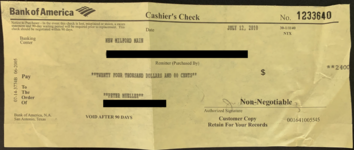
Original Window Sticker

Old Advertisement for this car on Autotrader.com in 2005

The car changed hands in 2010 for less than the 2005 advertised price (perhaps still depreciating at that point)
(note I have been advised by @Jimbo that the seller in 2010 passed away some time ago)

Jeff - some interesting comparisons with my '93 Red.
My serial #979484 - quite a ways off
My engine # 007967 - close
My ship # 3095 - close
My car came in thru LA to Hutchinson Motors in Walnut Creek.
Don't know why the VINs would be so far off?
Oh, and my list price is $30.00 higher for Cali emissions test...
My serial #979484 - quite a ways off
My engine # 007967 - close
My ship # 3095 - close
My car came in thru LA to Hutchinson Motors in Walnut Creek.
Don't know why the VINs would be so far off?
Oh, and my list price is $30.00 higher for Cali emissions test...
Oh weird. They had to emissions test your car when NEW?Jeff - some interesting comparisons with my '93 Red.
My serial #979484 - quite a ways off
My engine # 007967 - close
My ship # 3095 - close
My car came in thru LA to Hutchinson Motors in Walnut Creek.
Don't know why the VINs would be so far off?
Oh, and my list price is $30.00 higher for Cali emissions test...
2 years later! 4000 more miles and I (phew) passed smog again. It is always a nerve wracking experience passing smog in CA. HC and CO number are low, but just a tad higher than last time. Same shop, same tech.It has already been 2 years since the last smog check! With the pandemic going on, traffic is very light. It is only a 30 min drive all at freeway speeds to my fav smog place - Holly Smog in San Carlos. If anyone needs a smog in the Bay Area, Andrew and Luis at Holly Smog are pros. When they lift the hood, the first that they do is actuate the latch to make the hood go 90* so that heat doesn’t build up while performing the tests. Actually this is one side benefit of a 90s car with non defeatable traction control —- in CA, the only smog test needed is the stationary sniffer test. No dyno run needed.
The car passed w good results, and we chatted about Andrew’s Dodge Conquest w LS swap and the 240SX on his lift that he’s stripped and is restoring.
View attachment 114785

I was also talking to my awesome smog guy about aftermarket cats (for when the OE one fails in the future). He helpfully printed out this guidance from the BAR for me. Note the underline part —- techs are supposed to check that the CARB EO number falls within the correct vehicle category (but they do not have to check for specific application for pre OBD2 cars!).

Jlaa, don't worry about the emissions testing. Low double digit HC is fantastic for any M119, single digits will be as good as you'll ever get. When the numbers start nearing triple digits, then you can worry (assuming the cats were fully heated, which is required to get good numbers).

Not to turn @Jlaa's thread into a hi-fi thread but, I have 3 of these (rare now) Sony Super Metal Master Ceramic cassettes, the sound is unreal for a cassette tape compared to type i or type ii cassettesMy son and I were discussing this… he plays wax in his dorm room to a Bluetooth speaker I got him… this type of setup is really tempting me… but I know, it’s hustling backwards.
maw
Attachments
Does the smog test state the lambda value ?2 years later! 4000 more miles and I (phew) passed smog again. It is always a nerve wracking experience passing smog in CA. HC and CO number are low, but just a tad higher than last time. Same shop, same tech.
View attachment 151686
I was also talking to my awesome smog guy about aftermarket cats (for when the OE one fails in the future). He helpfully printed out this guidance from the BAR for me. Note the underline part —- techs are supposed to check that the CARB EO number falls within the correct vehicle category (but they do not have to check for specific application for pre OBD2 cars!).
View attachment 151687
It measures HC and C02 and C0 under specific conditions, which is a function of lambda, but it doesn't explicitly report on lambda.Does the smog test state the lambda value ?
@Jlaa, Why the sweaty palms? The M119 will pass CA Smog with flying colors. I was assured that by Glen after my car sat for 3-1/2 years and all I did was fill the tank w/Arco Premium and a bottle of Chevron Techron. Drove about 30 miles on the freeway and2 years later! 4000 more miles and I (phew) passed smog again. It is always a nerve wracking experience passing smog in CA. HC and CO number are low, but just a tad higher than last time. Same shop, same tech.
View attachment 151686
I was also talking to my awesome smog guy about aftermarket cats (for when the OE one fails in the future). He helpfully printed out this guidance from the BAR for me. Note the underline part —- techs are supposed to check that the CARB EO number falls within the correct vehicle category (but they do not have to check for specific application for pre OBD2 cars!).
View attachment 151687
 It passed
It passedPS: Glen’s “High-Miler w/ 662,527 miles on the clock just passed CA Smog on 8/01/2022

RELAX! I’m sure as meticulous as you are and it’s banging on all 8 cylinders you have “No Worries”
 for a long time
for a long timelol
Paranoia maybe? I will use an analogy I am sure you might appreciate. Taking a car to smog for me is like taking a residential project through building inspection / plumbing inspection / electrical inspection / whatever. Always those code guys can find something to pick apart.@Jlaa, Why the sweaty palms? The M119 will pass CA Smog with flying colors. I was assured that by Glen after my car sat for 3-1/2 years and all I did was fill the tank w/Arco Premium and a bottle of Chevron Techron. Drove about 30 miles on the freeway andIt passed
PS: Glen’s “High-Miler w/ 662,527 miles on the clock just passed CA Smog on 8/01/2022
RELAX! I’m sure as meticulous as you are and it’s banging on all 8 cylinders you have “No Worries”for a long time
lol
I understand your logicParanoia maybe? I will use an analogy I am sure you might appreciate. Taking a car to smog for me is like taking a residential project through building inspection / plumbing inspection / electrical inspection / whatever. Always those code guys can find something to pick apart.

my car passed the smog test too,made sure i drove it at a high speed for about 20 minutes and passed with ease.
This bracket has always bothered me in all of its disgusting crudeness and rustiness.
I don't know why these brackets seem to disintegrate more quickly than the rest of the car but .... I had to do something about it.
Yuck:
![[500Eboard] IMG_5122.jpeg [500Eboard] IMG_5122.jpeg](https://www.500eboard.co/forums/data/attachments/163/163316-9c7be24ac3f9cec78714d36791079c44.jpg?hash=nHviSsP5zs)
![[500Eboard] IMG_5119.jpeg [500Eboard] IMG_5119.jpeg](https://www.500eboard.co/forums/data/attachments/163/163319-14ddefd2b7a9a820486b999ea50465ab.jpg?hash=FN3v0repqC)
Of course what is any project, no matter how straightforward / simple, without some aggravation. Reverse drill bit to the rescue:
![[500Eboard] IMG_5143.jpeg [500Eboard] IMG_5143.jpeg](https://www.500eboard.co/forums/data/attachments/163/163315-2b71464634d75a4124101f047cc7b669.jpg?hash=K3FGRjTXWk)
![[500Eboard] IMG_5145.jpeg [500Eboard] IMG_5145.jpeg](https://www.500eboard.co/forums/data/attachments/163/163314-e7d15240d7e7425020247c4717990729.jpg?hash=59FSQNfnQl)
![[500Eboard] IMG_5153.jpeg [500Eboard] IMG_5153.jpeg](https://www.500eboard.co/forums/data/attachments/163/163313-05dbe14aef14ca0b33fffb2d4bf15c2a.jpg?hash=BdvhSu8Uyg)
Removed - look at all that grossness!
![[500Eboard] IMG_5135.jpeg [500Eboard] IMG_5135.jpeg](https://www.500eboard.co/forums/data/attachments/163/163312-33f1da26f43b6fc05227a5ef3128b13a.jpg?hash=M_HaJvQ7b8)
![[500Eboard] IMG_5131.jpeg [500Eboard] IMG_5131.jpeg](https://www.500eboard.co/forums/data/attachments/163/163318-0d16ef733f6e62f7b8bf3f5452829cac.jpg?hash=DRbvcz9uYv)
After wire wheel, some grinding stone, and brake parts cleaner:
![[500Eboard] IMG_5139.jpeg [500Eboard] IMG_5139.jpeg](https://www.500eboard.co/forums/data/attachments/163/163311-2e1a13db934e9550e80d55aaf129add6.jpg?hash=LhoT25NOlV)
![[500Eboard] IMG_5137.jpeg [500Eboard] IMG_5137.jpeg](https://www.500eboard.co/forums/data/attachments/163/163317-4b73dd09220b0c46b9fe9158d5159166.jpg?hash=S3PdCSILDE)
Painted with rustoleum rust converter, hit with a heat gun to accelerate drying, then VHT brake caliper paint, then more heat gun, then install. Much better. Ignore the corroded nuts --- waiting on those for delivery. But I wire wheeled the rest of the hardware and used anti seize this time around. Little wins made possible by QuickJack!
![[500Eboard] IMG_5159.jpeg [500Eboard] IMG_5159.jpeg](https://www.500eboard.co/forums/data/attachments/163/163310-e208f609c8a0dc84f7514ab4b82cb306.jpg?hash=4gj2Ccig3I)
![[500Eboard] IMG_5167.jpeg [500Eboard] IMG_5167.jpeg](https://www.500eboard.co/forums/data/attachments/163/163309-10cc108cb2fda5313c82ebfc38777213.jpg?hash=EMwQjLL9pT)
I don't know why these brackets seem to disintegrate more quickly than the rest of the car but .... I had to do something about it.
Yuck:
![[500Eboard] IMG_5122.jpeg [500Eboard] IMG_5122.jpeg](https://www.500eboard.co/forums/data/attachments/163/163316-9c7be24ac3f9cec78714d36791079c44.jpg?hash=nHviSsP5zs)
![[500Eboard] IMG_5119.jpeg [500Eboard] IMG_5119.jpeg](https://www.500eboard.co/forums/data/attachments/163/163319-14ddefd2b7a9a820486b999ea50465ab.jpg?hash=FN3v0repqC)
Of course what is any project, no matter how straightforward / simple, without some aggravation. Reverse drill bit to the rescue:
![[500Eboard] IMG_5143.jpeg [500Eboard] IMG_5143.jpeg](https://www.500eboard.co/forums/data/attachments/163/163315-2b71464634d75a4124101f047cc7b669.jpg?hash=K3FGRjTXWk)
![[500Eboard] IMG_5145.jpeg [500Eboard] IMG_5145.jpeg](https://www.500eboard.co/forums/data/attachments/163/163314-e7d15240d7e7425020247c4717990729.jpg?hash=59FSQNfnQl)
![[500Eboard] IMG_5153.jpeg [500Eboard] IMG_5153.jpeg](https://www.500eboard.co/forums/data/attachments/163/163313-05dbe14aef14ca0b33fffb2d4bf15c2a.jpg?hash=BdvhSu8Uyg)
Removed - look at all that grossness!
![[500Eboard] IMG_5135.jpeg [500Eboard] IMG_5135.jpeg](https://www.500eboard.co/forums/data/attachments/163/163312-33f1da26f43b6fc05227a5ef3128b13a.jpg?hash=M_HaJvQ7b8)
![[500Eboard] IMG_5131.jpeg [500Eboard] IMG_5131.jpeg](https://www.500eboard.co/forums/data/attachments/163/163318-0d16ef733f6e62f7b8bf3f5452829cac.jpg?hash=DRbvcz9uYv)
After wire wheel, some grinding stone, and brake parts cleaner:
![[500Eboard] IMG_5139.jpeg [500Eboard] IMG_5139.jpeg](https://www.500eboard.co/forums/data/attachments/163/163311-2e1a13db934e9550e80d55aaf129add6.jpg?hash=LhoT25NOlV)
![[500Eboard] IMG_5137.jpeg [500Eboard] IMG_5137.jpeg](https://www.500eboard.co/forums/data/attachments/163/163317-4b73dd09220b0c46b9fe9158d5159166.jpg?hash=S3PdCSILDE)
Painted with rustoleum rust converter, hit with a heat gun to accelerate drying, then VHT brake caliper paint, then more heat gun, then install. Much better. Ignore the corroded nuts --- waiting on those for delivery. But I wire wheeled the rest of the hardware and used anti seize this time around. Little wins made possible by QuickJack!
![[500Eboard] IMG_5159.jpeg [500Eboard] IMG_5159.jpeg](https://www.500eboard.co/forums/data/attachments/163/163310-e208f609c8a0dc84f7514ab4b82cb306.jpg?hash=4gj2Ccig3I)
![[500Eboard] IMG_5167.jpeg [500Eboard] IMG_5167.jpeg](https://www.500eboard.co/forums/data/attachments/163/163309-10cc108cb2fda5313c82ebfc38777213.jpg?hash=EMwQjLL9pT)
Love this! Had a similar rusty bracket holding a hose in my 560SEC. Small, but stuck out like a sore thumb to me. 20 minutes of wire wheel plus spray paint and I'm sleeping easy at night. Paint the back of the fence, as Steve Job's Dad used to tell him...
While working, Paul shared a piece of advice with Jobs: “You've got to make the back of the fence, that nobody will see, just as good looking as the front of the fence,” Isaacson told “60 Minutes.” “Even though nobody will see it, you will know, and that will show that you're dedicated to making something perfect.”
While working, Paul shared a piece of advice with Jobs: “You've got to make the back of the fence, that nobody will see, just as good looking as the front of the fence,” Isaacson told “60 Minutes.” “Even though nobody will see it, you will know, and that will show that you're dedicated to making something perfect.”
East Coast! From what I can piece together of this car's ownership:Nice work @Jlaa!
I was surprised by the level of corrosion you found. Where did your car live prior to your purchase?
- Stockbroker in NY. Made it big, bought the car with cash and retired to AZ.
- Peter Mueller then acquired the car when the stockbroker (who was Mueller's classmate) was dying of cancer. As I understand, Mueller was an auto wholesaler in the East Coast and may or may not have been with the Hitler Youth. He passed in his 70s and was a heavy smoker/drinker. The car from what I understand was super special to him and he often brought it to shows.
- <Name Redacted> then acquired the car. The father of this individual went to prison over 99 counts of bank fraud, filing false tax returns, and insider trading.
- Jeff093 in New Hampshire acquired the car.
- Moi! Luckily my life is rather dull and devoid of drama!


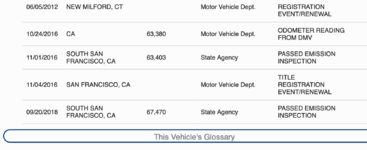
Nice. I should point out that I wire-wheeled these nuts to remove corrosion. I don't know if wire-wheeling these removes any plating on these either, so I've ordered new nuts too. When I receive the new nuts as well as the two new copper nuts that bolt onto the exhaust, I will drop and clean the cast aluminum transmission support bracket too.Love this! Had a similar rusty bracket holding a hose in my 560SEC. Small, but stuck out like a sore thumb to me. 20 minutes of wire wheel plus spray paint and Im sleeping easy at night. Paint the back of the fence, as Steve Jobs Dad used to tell him...
While working, Paul shared a piece of advice with Jobs: “Youve got to make the back of the fence, that nobody will see, just as good looking as the front of the fence,” Isaacson told “60 Minutes.” “Even though nobody will see it, you will know, and that will show that youre dedicated to making something perfect.”




Fascinating!East Coast! From what I can piece together of this cars ownership:
FWIW I was surprised at the hidden corrosion on the back of this exhaust bracket - the part that faces the exhaust mounting. I am not sure if this is because it is painted metal on metal contact here on something that moves/vibrates (the exhaust) or if the bolt plate itself is mild steel and rusts or what --- but I wonder if the back of the bracket on many peoples cars has corrosion ......
- Stockbroker in NY. Made it big, bought the car with cash and retired to AZ.
- Peter Mueller then acquired the car when the stockbroker (who was Muellers classmate) was dying of cancer. As I understand, Mueller was an auto wholesaler in the East Coast and may or may not have been with the Hitler Youth. He passed in his 70s and was a heavy smoker/drinker. The car from what I understand was super special to him and he often brought it to shows.
- then acquired the car. The father of this individual went to prison over 99 counts of bank fraud, filing false tax returns, and insider trading.
- Jeff093 in New Hampshire acquired the car.
- Moi! Luckily my life is rather dull and devoid of drama!
View attachment 163496
View attachment 163497
I love how much you have been able to put together regarding the past owners and the lives they lived!
shoe sizes.........I'm missing any info on the shoe sizes here.Fascinating!
I love how much you have been able to put together regarding the past owners and the lives they lived!
Weekend project. I cleaned up the filthy transmission mounting bracket and polished 1 surface of the transmission pan. Ugh. That trans bracket was gross. It took a whole can of brake cleaner and many qtips to get it back to looking shiny….. 90 mins worth of cleaning! Also, I love the right angle drill I bought some time ago.
My next tool purchase will be an ultrasonic cleaner.








My next tool purchase will be an ultrasonic cleaner.








Last edited:
Perfect post-SVB handiwork. Well done!
@TimL the shoe sizes are the sizes of shoes you would have needed to appreciate and own one of these cars in the mid-90s [by any means necessary]. Either you were a Formula One driver, or a car dealership owner, or... or. There weren't many other options. Mine came from a car dealership owner (and, no not just any dealership), passed to a racing team owner (still a good friend of mine), passed to me.
My S55 ownership looks like what @Jlaa describes above, minus any jail time and probably any Hitler Youth. Probably. I haven't checked.
;-D
Cheers,
maw
@TimL the shoe sizes are the sizes of shoes you would have needed to appreciate and own one of these cars in the mid-90s [by any means necessary]. Either you were a Formula One driver, or a car dealership owner, or... or. There weren't many other options. Mine came from a car dealership owner (and, no not just any dealership), passed to a racing team owner (still a good friend of mine), passed to me.
My S55 ownership looks like what @Jlaa describes above, minus any jail time and probably any Hitler Youth. Probably. I haven't checked.
;-D
Cheers,
maw
Last edited:
YessssssWeekend project. I cleaned up the filthy transmission mounting bracket and polished 1 surface of the transmission pan. Ugh. That trans bracket was gross. It took a whole can of brake cleaner and many qtips to get it back to looking shiny….. 90 mins worth of cleaning! Also, I love the right angle drill I bought some time ago.
My next tool purchase will be an ultrasonic cleaner.
View attachment 163745 View attachment 163746 View attachment 163748 View attachment 163749 View attachment 163750 View attachment 163751 View attachment 163753 View attachment 163752
Buy the biggest ultrasonic cleaner you can fit. Then buy gallon jugs of simple green extreme off amazon.
While your wallet might not thank u, you’ll never think about investing in q-tip stock again.
Yeah... the garage tool I fell in love with at first sight was the media blaster. Then the lathe. But of course those aren't exactly residential garage tools. Thank God for friends. One day I'm gonna figure out how to own a shop with someone I bring out of retirement.
maw
maw
Thanks! I read that SG is corrosive to alu parts - is that why you use SG Extreme? (SGE being not corrosive?)Yessssss
Buy the biggest ultrasonic cleaner you can fit. Then buy gallon jugs of simple green extreme off amazon.
While your wallet might not thank u, you’ll never think about investing in q-tip stock again.
BTW I still need qtips. Because 3 piece wheels.
I used shop’s ginormous sand blast cabinet w huuuuuuuuuuuge shop sized compressor to blast off the finish off 4 old Citroën TRX sized wheels some years ago. That’s when I realized sand blasting a tiny little line at a time actually makes blasting a whole big thing take longer than one might imagine!!Yeah... the garage tool I fell in love with at first sight was the media blaster. Then the lathe. But of course those arent exactly residential garage tools. Thank God for friends. One day Im gonna figure out how to own a shop with someone I bring out of retirement.
maw
Yes exactly. SGE is safe on aluminum and it used throughout the aviation industry.Thanks! I read that SG is corrosive to alu parts - is that why you use SG Extreme? (SGE being not corrosive?)
BTW I still need qtips. Because 3 piece wheels.
I used shop’s ginormous sand blast cabinet w huuuuuuuuuuuge shop sized compressor to blast off the finish off 4 old Citroën TRX sized wheels some years ago. That’s when I realized sand blasting a tiny little line at a time actually makes blasting a whole big thing take longer than one might imagine!!
off topic but you mentioned manual. I often try to run thru the gears manually every time I think of it. Not sure it matter to the transmission but making sure at temp that I shift at the factory shift points/RPM sometimes is more than the automatic shifting allows for. Besides, it s fun in both the C126 and the W124.
Similar threads
- Replies
- 21
- Views
- 1,430
- Replies
- 74
- Views
- 6,808




